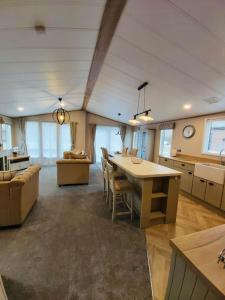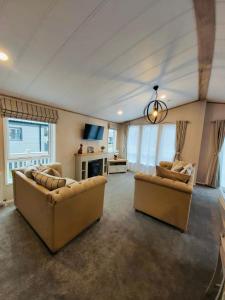Best Shopping Malls in Bielby Area
We've collected top 10 mentioned shopping malls in Bielby from other articles such as york360.co.uk, datagemba.com.
Best Shopping Malls in Bielby Area

Coppergate Shopping Centre
Covered walkways of high street fashion and lifestyle stores in open-air shopping centre with cafes.
12 Coppergate Walk, York, YO1 9WY, United Kingdom
Shopping mall
Monks Cross Shopping Park
Shopping centre with major fashion and food retailers plus fast food, coffee and free parking.
Monks Cross Dr, Huntington, York YO32 9GX, United Kingdom
Shopping mall
Vangarde Shopping Park
Spacious upscale mall offering a variety of brand-name stores & eateries in a modern setting.
Vangarde Way, Huntington, York YO32 9AE, United Kingdom
Shopping mall
Anlaby Retail Park
Springfield Way, Anlaby, Hull HU10 6SJ, United Kingdom
Shopping mallMentioned by datagemba.com
20 Best Shopping Centre in Kingston Upon Hull, United Kingdom

Saint Andrew's Retail Park
Hessle Rd, Hull, HU3 4EB, United Kingdom
Shopping mallMentioned by datagemba.com
20 Best Shopping Centre in Kingston Upon Hull, United Kingdom

Dunswell Car Boot
41 Beverley Rd, Dunswell, Hull HU6 0AD, United Kingdom
Shopping mallMentioned by datagemba.com
20 Best Shopping Centre in Kingston Upon Hull, United Kingdom
Best Spas in Bielby

Plush Nails & Beauty
9 Princes Ave, Hull, HU5 3RX, United Kingdom
Beauty salonFacial spaNail salonWaxing hair removal serviceMentioned by datagemba.com
20 Best Shopping Centre in Kingston Upon Hull, United Kingdom

The Sanctuary
149 Newland Ave, Hull, HU5 2ER, United Kingdom
ReflexologistFacial spaMassage therapistMentioned by Things To Do
in Kingston-upon-Hull, England: The Best Spas & Wellness

Village Hotel Hull
Bright rooms with free Wi-Fi in a modern hotel offering a pub, a grill restaurant and a pool.
Henry Boot Way, Hull, HU4 7DY, United Kingdom
HotelSpaWedding venueMentioned by HullLive
The best and worst hotels in Hull
Mentioned by datagemba.com
20 Best Hotels in Kingston Upon Hull, United Kingdom
Top 10 Free Things To Do and Attractions in Bielby

Rowntree Park
Leafy public park with features such as playgrounds, picnic areas, tennis courts & a sizable lake.
Terry Ave, York, YO23 1JQ, United Kingdom
ParkNature & ParksMentioned by Culture Trip
The Most Beautiful Parks in and Around York
"Rowntree Park, on the flood plains of the River Ouse, is a myriad of paths and walkways along the river. It was York’s first ever municipal park, presented to the public by sweets company Rowntree & Co to commemorate the 200 members of their staff who died in World War I. If you’re in search of a little exercise during your visit, the park boasts six tennis courts, a skate park, a basketball court, two tennis tables and two bowling greens. The duck pond also makes for an excellent picnicking spot."
Mentioned by greatvaluevacations.com
10 Free Things to Do in York
"For a scenic afternoon in the park, head over to Rowntree Park. The park is located on the banks of the River Ouse and was built as a scenic memorial to the soldiers who fought in the two World Wars. The 30-acre area holds children’s play areas, a lake, flower beds, woodlands, and facilities for bowling, tennis, and basketball."
Mentioned by campsites.co.uk
8 commonly overlooked free things to do in York
"Located on the banks of the River Ouse, Rowntree Park was built as a scenic memorial to those who fought in the World Wars. Across its 30 acres, you will find children’s play areas as well as facilities for bowling, tennis and basketball. Enjoy walking around the lake, woodland and flower beds for free!"

Clifford's Tower, York
13th-century castle keep, built on a grass mound, formerly used as a prison and royal mint.
Tower St, York, YO1 9SA, United Kingdom
Historical landmarkSights & LandmarksFortressHeritage buildingHistoric SitesObservation Decks & TowersPoints of Interest & LandmarksMentioned by iknow-uk.com
York Museums
"Family friendly York Castle Museum is centrally situated near Coppergate Shopping Centre – green signs direct you to the ‘Castle Area’. Collections of Costume and Textiles, Military and Social History and a collection on York Castle’s most famous prisoner Dick Turpin, eventually hanged in 1739, all feature in exhibitions. A favourite with children, the recreated Victorian and Georgian rooms here display historic every day items from the collection of North Yorkshire country doctor John Kirk."
Mentioned by Medieval York
Medieval York
Mentioned by Within the old city walls
Within the old city walls

University of Hull
Cottingham Rd, Hull, HU6 7RX, United Kingdom
UniversitySights & LandmarksUniversities & SchoolsMentioned by Earth's Attractions - travel guides by locals, travel itineraries, travel tips, and more
A local's guide to Kingston upon Hull, UK
"Recognised as one of the best universities in Yorkshire, the University of Hull is a worthy destination to visit with its large and photogenic campus. There are many eating facilities on campus during school days as well, ranging from street food to catered fine dining."
Mentioned by Things To Do
Top 10 Sights & Landmarks in Kingston-upon-Hull, England
Mentioned by whichmuseum.co.uk
Top 10 best museums in Hull - WhichMuseum
Historic Sites in Bielby

Merchant Adventurers' Hall
1350s building where merchants congregated, with a chapel & an alms house (open daily in summer).
Fossgate, York, YO1 9XD, United Kingdom
History museumSights & LandmarksEvent venueHistorical landmarkNon-profit organizationWedding venueArchitectural BuildingsHistoric SitesMentioned by GPSmyCity
City Walk: York's Historical Architecture, York, England
"This guildhall in the city of York was one of the most important buildings in the medieval city. The majority of the Hall was built in 1357 by a group of influential men and women who came together to form a religious fraternity called the Guild of Our Lord Jesus and the Blessed Virgin Mary. The main part of the building consists of the Great Hall, the Undercroft and the Chapel."
Mentioned by Britain Visitor - Travel Guide To Britain
York Museums
"The Merchant Adventurers' Hall is a restored medieval guildhall dating from the 14th century. The Great Hall is Britain's largest timber-framed building still used for its original purpose. The hall is still used by the Company of Merchant Adventurers of the City of York, now a charitable organization."
Mentioned by Tripadvisor's Top Things to Do
Top things to do in York

York Cold War Bunker
Fallout monitoring centre in case of nuclear war until 1990s, now open and run by English Heritage.
Monument Cl, Holgate, York YO24 4HT, United Kingdom
Historical place museumSights & LandmarksHeritage buildingHistorical landmarkHistoric SitesMentioned by Culture Trip
The Top 10 Museums And Galleries In York
"The York Cold War Bunker has to be one of the city’s most captivating attractions. Tucked down a quiet residential cul-de-sac, you’ll find the inconspicuous entrance through an industrial-looking bomb-proof door. Go past the decontamination room, and down to the control centre, dormitory, and staff room where, for more than 30 years, this place hummed with activity, staffed by volunteers ready to map and manage the fallout from a nuclear blast."
Mentioned by History Hit
10 of the Best Historic Sites in York
"A mile outside of the city centre, York Cold War Bunker tells the story of a country on the brink of nuclear warfare. Designed to monitor nuclear fallout in the event of an attack in Yorkshire, the semi-submerged bunker affords visitors the chance to explore some of York’s more unusual history. Built in 1961, the bunker served as the regional headquarters for the Royal Observer Corps until 1991."
Mentioned by BSC (EN)
A Guide to the Best Museums in York | York Attractions
"Experience life in a cold war bunker and discover the history of the volunteers who would have played a vital role in ensuring Britain could withstand a nuclear attack. Through a one hour guided tour, you’ll learn about this recent period in British history and how the people of York prepared for the threat of nuclear war."

Roman Column
Only remaining column of 36 that once supported a grand Roman hall, with an informational plaque.
11 Minster Yard, York, YO1 7HH, United Kingdom
Historical landmarkSights & LandmarksHistoric SitesMonuments & StatuesPoints of Interest & LandmarksVacation Rentals, Airbnb, Hotels & Cabins near Bielby







Lesta Cottage
cottage
$125.25 /night
View deal










Waters Edge Lodge with Hot Tub
lodge
$202.5 /night
View deal







Wayside Cottage
cottage
$157 /night
View deal
Best Things To Do Categories in Bielby
* The displayed nightly rate may be estimated based on a future travel date. Narrow down your search with checkin and checkout dates to see the exact price.